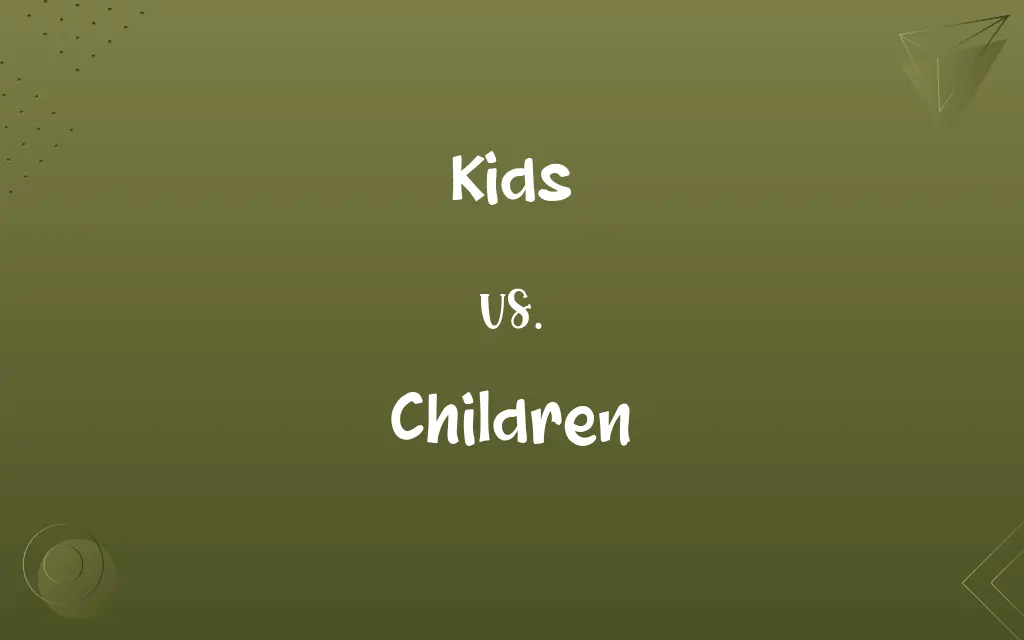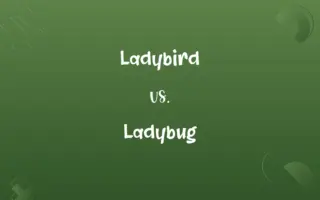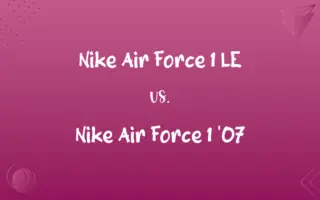Kids vs. Children: Know the Difference

By Hifza Nasir & Dua Fatima || Published on March 16, 2024
Kids and children refer to young humans, but "kids" is more informal and often connotes a sense of playfulness or affection, while "children" is more formal and used in legal, educational, or formal writing contexts.

Key Differences
"Kids" and "children" both denote young humans, typically from birth until puberty, but their usage contexts differ significantly. "Kids" is informal, often used in casual conversation or when speaking with a sense of warmth and familiarity. It's commonly heard in everyday speech, among parents discussing their own offspring, or in marketing targeting a younger audience. "Children," on the other hand, carries a more formal tone, preferred in official documents, educational settings, and when addressing topics with a serious or legal undertone.
Dua Fatima
Mar 16, 2024
The term "kids" can sometimes imply a more playful, energetic aspect of youth, capturing the carefree and spirited nature of being young. Advertisements, books, and media aimed at young audiences frequently use "kids" to establish a relatable, friendly approach. Conversely, "children" is used in contexts requiring precision or a formal tone, such as in policy discussions, educational curricula, or when emphasizing rights and protections under the law, highlighting its authoritative and universal application.
Hifza Nasir
Mar 16, 2024
Cultural perceptions also play a role in the preferred usage of these terms. In some cultures or contexts, "kids" might be deemed too casual or disrespectful, especially in formal or ceremonial situations. "Children" is universally accepted and is less likely to be viewed as inappropriate or overly casual in diverse settings, from academic research to international treaties on child welfare.
Hifza Nasir
Mar 16, 2024
The choice between "kids" and "children" can reflect the speaker's relationship to the subjects or the intended tone of the communication. For instance, a teacher might refer to her students as "children" when discussing academic performance with parents, but use "kids" when engaging in a more casual, supportive conversation with the same parents about their day-to-day challenges and achievements.
Hifza Nasir
Mar 16, 2024
Despite these nuances, the interchangeability of "kids" and "children" in many contexts underscores the fluidity of language and social conventions. While "kids" may offer a more colloquial, affectionate framing, "children" provides a universally understood term that conveys respect and formality, making it suitable for a wide range of discourses about youth.
Hifza Nasir
Mar 16, 2024
ADVERTISEMENT
Comparison Chart
Tone
Informal, often conveys warmth and affection.
Formal, preferred in legal, educational, or formal writing.
Hifza Nasir
Mar 16, 2024
Usage Context
Casual conversation, family settings, marketing to younger audiences.
Official documents, academic research, policy discussions.
Dua Fatima
Mar 16, 2024
Connotation
Playfulness, energy, and a sense of carefreeness.
Seriousness, formality, and a focus on rights/protections.
Dua Fatima
Mar 16, 2024
Cultural Perception
May be seen as too casual or disrespectful in some contexts.
Universally accepted and appropriate in diverse settings.
Hifza Nasir
Mar 16, 2024
Examples of Use
"The kids are playing in the yard."
"Children have the right to education."
Shumaila Saeed
Mar 16, 2024
ADVERTISEMENT
Kids and Children Definitions
Children
Used in official or educational contexts.
The school's policy on children's safety is very strict.
Hifza Nasir
Feb 29, 2024
Children
Formal term for young humans.
All children are entitled to basic human rights.
Hifza Nasir
Feb 29, 2024
ADVERTISEMENT
Children
Conveys a sense of seriousness.
Children's development is influenced by their environment.
Hifza Nasir
Feb 29, 2024
Children
Universal and respectful.
This charity works to improve the lives of children worldwide.
Shumaila Saeed
Feb 29, 2024
Kids
Implies energy and playfulness.
The park was full of kids laughing and running around.
Hifza Nasir
Feb 29, 2024
Children
Policy and legal discussions.
The legislation focuses on the protection of children.
Dua Fatima
Feb 29, 2024
Kids
(Slang)Pal. Used as a term of familiar address, especially for a young person
Hi, kid! What's up?.
Dua Fatima
Feb 28, 2024
Repeatedly Asked Queries
Are there contexts where "children" is clearly preferred?
Yes, in legal, educational, and policy-related discussions, "children" is the preferred term.
Shumaila Saeed
Mar 16, 2024
What is the difference between kids and children?
"Kids" is informal and often conveys affection, while "children" is formal and used in serious or official contexts.
Dua Fatima
Mar 16, 2024
Is it incorrect to use "kids" in formal writing?
While not incorrect, "children" is preferred in formal writing to maintain a professional tone.
Hifza Nasir
Mar 16, 2024
Why might someone choose to use "kids" over "children"?
To convey warmth, familiarity, or playfulness, or when speaking informally about young people.
Hifza Nasir
Mar 16, 2024
Can the term "children" apply to teenagers?
Yes, "children" can broadly apply to all individuals under the age of majority, though teenagers are often specifically referred to as such.
Hifza Nasir
Mar 16, 2024
What term should be used in academic research involving young people?
"Children" is preferred in academic research for its formality and clarity.
Hifza Nasir
Mar 16, 2024
Is the term "kids" considered disrespectful?
It can be seen as too casual in some contexts, but generally, it's not considered disrespectful.
Hifza Nasir
Mar 16, 2024
Can the preference for one term over the other change over time?
Yes, language evolves, and social preferences for these terms may shift based on cultural trends and contexts.
Hifza Nasir
Mar 16, 2024
Can "children" be used in a casual conversation?
Yes, "children" can be used casually, though "kids" is more common in informal settings.
Hifza Nasir
Mar 16, 2024
Is there a legal definition that differentiates kids from children?
Legally, both terms refer to individuals under the age of majority, but "children" is the term used in legal contexts.
Hifza Nasir
Mar 16, 2024
Does the media have an influence on the use of "kids" vs. "children"?
Yes, media targeting younger audiences tends to prefer "kids" for its relatability and informal tone.
Hifza Nasir
Mar 16, 2024
How do cultural perceptions influence the use of these terms?
Cultural norms and the formality of the setting can dictate whether "kids" or "children" is more appropriate.
Hifza Nasir
Mar 16, 2024
In what way do educational settings typically use these terms?
Educational settings usually prefer "children" when referring to students in a formal or academic context.
Dua Fatima
Mar 16, 2024
How does the choice between these terms affect communication with parents?
Using "kids" may create a more relaxed, empathetic dialogue, while "children" might be used for more formal or serious conversations.
Hifza Nasir
Mar 16, 2024
Do these terms have different implications for rights and protections?
"Children" is more commonly used in discussions about rights and protections due to its formal tone.
Hifza Nasir
Mar 16, 2024
Share this page
Link for your blog / website
HTML
Link to share via messenger
About Author
Written by
Hifza NasirCo-written by
Dua Fatima


































































